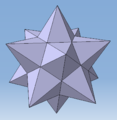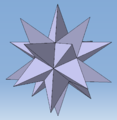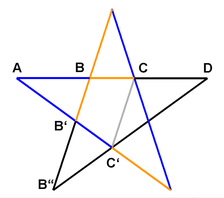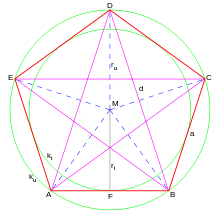Pentagram
![]()
This article is about the geometric figure. For other meanings, see Pentagram (disambiguation).
Pentagram (from ancient Greek πέντε pénte "five" and γραμμή grammē "line, stroke"; πεντάγραμμος pentágrammos "with five lines") denotes a form of the five-pointed star, also called five-pointed star, which results when one or two are skipped each time the five vertices are connected, and the chords thus produced are of equal length. This regular star is notated with the Schläfli symbol 


Pentagram,Schläfli symbol {5/2}, {5/3}.
Unicode
The pentagram is included in the Unicode block Miscellaneous Symbols. At code point U+26E4 (9956) ⛤ under the name "PENTAGRAM" and at code point U+26E7 (9959) ⛧ as "INVERTED PENTAGRAM".
Geometry
Construction
→ Main article: Pentagon
From five points distributed evenly, i.e. at intervals of 72°, on a circle, two five-axis symmetrical figures can be created by means of chords:
- The five chords between adjacent points form a regular pentagon with angles of 108° each.
- The five chords between non-adjacent points together form the pentagram with acute angles of 36°.
Geometric properties
The inner sections of the chords of the pentagram again form a regular pentagon. Compared to the outer it is rotated by 36°. The prongs of the pentagram are isosceles triangles. The angles between the base and the legs of these triangles are 72°.
The inner pentagon, together with two non-adjacent prongs each, forms an isosceles triangle with an obtuse apex, the 108° angle already mentioned.
If we draw another pentagram in the inner pentagon, its chords together with parts of the chords of the outer pentagram also form isosceles triangles with an obtuse apex of 108°. Their median perpendiculars are parallel to those of the pentagonal triangles, which in turn form the axes of symmetry of all pentagrams and pentagons.
Outer pentagon, pentagram and inner pentagon have the same center. Each chord of the inner pentagram is parallel to a chord of the outer pentagram located beyond the center.
All angles between the edges of the pentagram and the enclosing pentagon are therefore 36°, 72° or 108°. The five axes of symmetry have angles to the edges of 18°, 54° and 90°.
golden section
All chords and chordal parts of a pentagram bounded by intersections, including the outer and inner pentagons, have only four different lengths. Of these, each successive one is in the ratio of the golden section, i.e. the following length ratios are equal:
For example, it applies to the first ratio:
The triangle 


Due to the ray theorem holds:
Consider the relationship

then 

Formulas
| Mathematical formulas for the pentagram | ||
| Area | |
|
| | ||
| Scope | | |
| Tendon length | | |
| | ||
| | ||
| Side length of the inner pentagon | | |
| | ||
| | ||
| Aspect length of the outer pentagon | | |
| | ||
| | ||
| Perimeter radius | | |
| | ||
| | ||
Polyhedron with pentagrams
Some polyhedra have pentagrams as side faces, for example the dodecahedron star and the icosahedron star. These two polyhedra are Kepler-Poinsot solids.
· 
Dodecahedron star
· 
Icosahedron Star

Pentagram

The points A, B, C, D, E define a regular pentagon (red) and a pentagram (violet)

A fractal and self-similar pentagram
Questions and Answers
Q: What is a pentagram?
A: A pentagram is a five-pointed star, with all lines the same length and all angles the same.
Q: What other names are used to refer to a pentagram?
A: A pentangle, star pentagon, or pentalpha means the same thing as pentagram.
Q: What was the original meaning of the word pentacle?
A: The word pentacle originally meant 'any symbol that protects against evil spirits'.
Q: What is the second definition of 'pentacle' in modern Wicca?
A: The second definition of 'pentacle' in modern Wicca is 'a circumscribed pentagram', which means 'a pentagram drawn inside a circle so that the points of the pentagram touch the circle'.
Q: What is the significance of a pentagram in Wicca?
A: A pentagram is used as a symbol of protection and is a key symbol in Wicca.
Q: How have the meanings of pentagrams changed over time?
A: The meanings of pentagrams have changed over time and can vary from culture to culture. In modern Wicca, the pentagram is seen as a symbol of protection and spirituality.
Q: Are there other symbols that protect against evil spirits?
A: Yes, there are other symbols that protect against evil spirits. The pentagram is just one of many such symbols.
Search within the encyclopedia



















